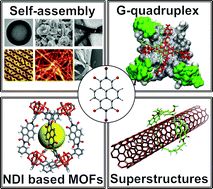Naphthalene diimides: perspectives and promise
Abstract
In this review, we describe the developments in the field of naphthalene diimides (NDIs) from 2016 to the presentday. NDIs are shown to be an increasingly interesting class of molecules due to their electronic properties, large electron deficient aromatic cores and tendency to self-assemble into functional structures. Almost all NDIs possess high electron affinity, good charge carrier mobility, and excellent thermal and oxidative stability, making them promising candidates for applications in organic electronics, photovoltaic devices, and flexible displays. NDIs have also been extensively studied due to their potential real-world uses across a wide variety of applications including supramolecular chemistry, sensing, host–guest complexes for molecular switching devices, such as catenanes and rotaxanes, ion-channels, catalysis, and medicine and as non-fullerene accepters in solar cells. In recent years, NDI research with respect to supramolecular assemblies and mechanoluminescent properties has also gained considerable traction. Thus, this review will assist a wide range of readers and researchers including chemists, physicists, biologists, medicinal chemists and materials scientists in understanding the scope for development and applicability of NDI dyes in their respective fields through a discussion of the main properties of NDI derivatives and of the status of emerging applications.



 Please wait while we load your content...
Please wait while we load your content...